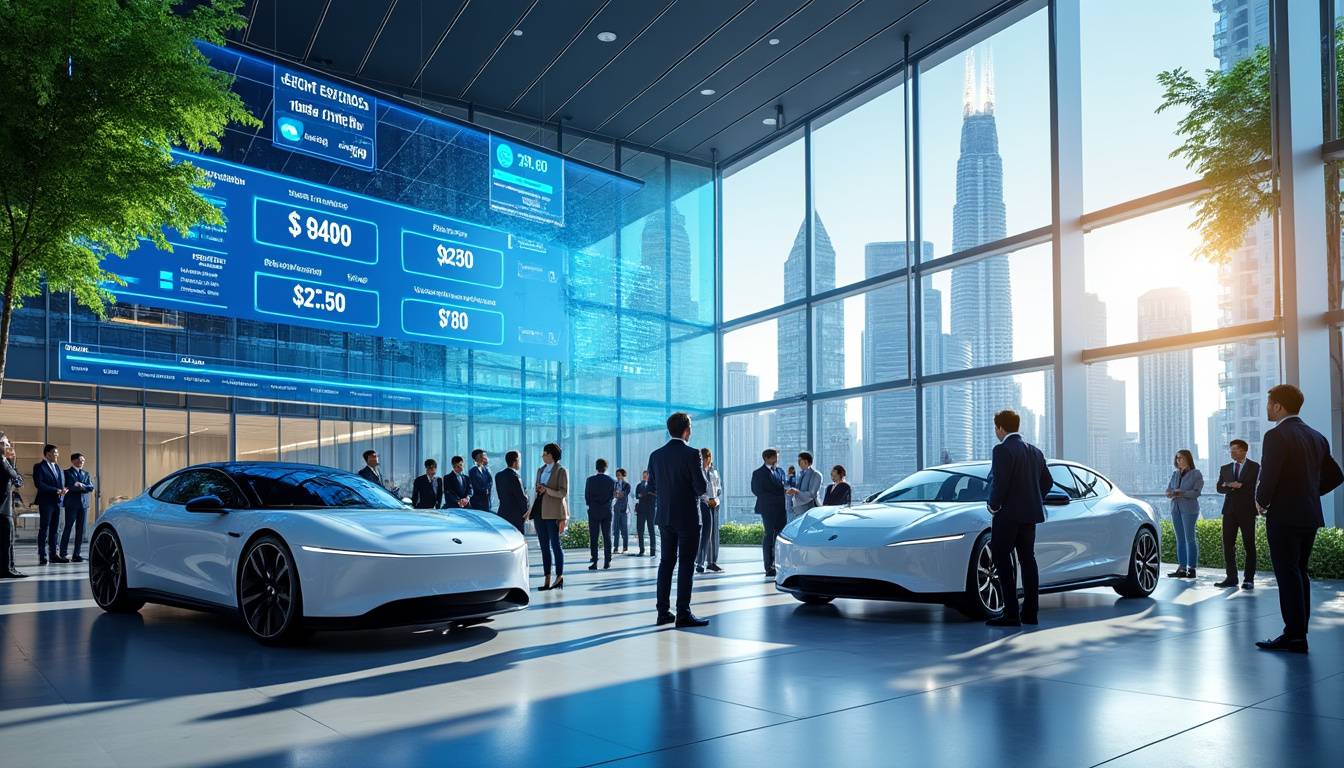As 2025 ushers in a new era for auto financing, consumers and industry professionals alike face a rapidly transforming marketplace shaped by economic shifts, technological advances, and evolving consumer preferences. Borrowers looking to purchase vehicles are contending with interest rates that, while more stable than the volatility witnessed in recent years, remain elevated compared to levels seen before the pandemic. Meanwhile, financing providers such as AutoNation, CarMax, and Capital One are refining loan structures and embracing digital platforms to offer more tailored and accessible auto loans. This article dives deep into the changing dynamics of auto loan rates, the rise of flexible financing solutions, and the critical role of credit quality in securing favorable rates. With data insights from trusted sources like Experian, LendingTree, and Bankrate, we explore how consumers can strategically navigate this complex environment to make informed decisions for the year ahead.
Current Trends in Auto Loan Rates and Their Impact on Borrowers
The landscape of auto loan rates in 2025 reflects a blend of economic recovery and cautious monetary policy. Interest rates on new vehicle loans hover near averages reported in late 2024, with borrowing costs for used cars generally higher due to increased risk factors. According to Experian’s latest data, the average interest rate for new car loans is approximately 6.35%, while used cars command rates closer to 11.62%. These figures illustrate the premium consumers pay when financing used vehicles, primarily due to depreciation concerns and the variable condition of pre-owned cars.
Borrowers with strong credit scores continue to enjoy the most favorable rates, highlighting the importance of credit management in the auto lending process. Platforms like Credit Karma and LendingTree stress that maintaining or improving credit scores remains a top priority to access lower APRs. Furthermore, diverse financing providers, ranging from banks like Synchrony Financial to retail lenders such as AutoNation, adjust their offers based on varying risk profiles and loan terms, emphasizing personalized loan options.
Breakdown of Average Auto Loan Rates by Credit Score
| Credit Score Range | New Car Loan APR (%) | Used Car Loan APR (%) |
|---|---|---|
| 720 and Above | 4.0 – 5.0 | 7.0 – 9.0 |
| 660 – 719 | 6.0 – 7.5 | 10.0 – 12.0 |
| 620 – 659 | 9.0 – 12.0 | 14.0 – 18.0 |
| 619 and Below | 15.0 – 20.0+ | 22.0 – 30.0+ |
For many consumers, understanding where their credit stands in this matrix is vital to anticipating the financing cost of a vehicle purchase. Those with higher scores benefit not only from reduced interest expenses but also access more competitive loan terms and can negotiate better deals with dealers like CarMax, which increasingly integrate financing and purchase offers.
- Higher credit scores drive down auto loan rates.
- Used car loans carry consistently higher rates than new car loans.
- Loan terms and lender policies vary widely, influencing financing costs.
Given these factors, prospective buyers are encouraged to utilize resources such as Bankrate and Kelley Blue Book to compare rates and vehicle valuations before committing. Preparing ahead by monitoring credit through tools offered by Credit Karma or checking loan prequalification at LendingTree can save thousands over the loan’s lifetime.
Innovations in Vehicle Financing Models: Flexibility and Consumer Control
Traditional auto loans remain prevalent, but 2025 sees a significant shift toward more innovative approaches to car financing. The rise of digital lending platforms and the influence of fintech companies like Capital One and Synchrony Financial contribute to increased flexibility and transparency for borrowers. These innovations include tailored loan durations, variable interest rate contracts, and financing options geared toward electric vehicle (EV) purchases.
In response to consumer demand for convenience and adaptability, lenders now offer:
- Shorter-term loans with lower overall interest costs.
- Flexible payment schedules, allowing payments aligned with income cycles.
- Loans specifically structured around EV warranties and incentives.
- Digital application and approval processes streamlined for quicker decisions.
These developments are propelled by the auto industry’s shift toward electric and hybrid vehicles, putting dealerships and lenders in a competitive position to accommodate new requirements. For example, incentives such as federal tax credits up to $7,500 for qualifying EVs, coupled with lower maintenance financing, stimulate loan product innovation.
Key Financing Options in 2025 for Different Vehicle Types
| Vehicle Type | Loan Options | Typical Term Length | Remarks |
|---|---|---|---|
| New Gasoline Cars | Standard fixed-rate loans, dealer financing | 36-72 months | Widely available, usually lower APRs |
| Used Gasoline Cars | Higher rate loans, refinancing options | 36-60 months | Interest rates elevated due to risk |
| Electric Vehicles (EVs) | Specialized loans, leasing, incentives incorporated | 24-72 months | Encouraged by federal tax rebates and local grants |
| Hybrid Vehicles | Combination loans with EV perks | 36-60 months | Growing segment with tailored financing |
Adopting these flexible models requires consumers to be proactive and well-informed to select the most advantageous options. Websites like Edmunds and AutoNation’s financing portals offer calculators and educational content targeting these innovations. Moreover, customers benefit from engaging with lending consultants who understand the evolving regulatory framework and the nuances of emerging vehicle technologies.
The Strategic Role of Credit Management in Securing Optimal Auto Loan Rates
Credit quality remains the cornerstone of affordable auto financing. As lenders continuously seek to mitigate risk, the borrower’s credit profile significantly impacts both rate offers and approval likelihood. In 2025, tools provided by platforms like Credit Karma and Experian allow consumers not only to monitor their credit but also to simulate the impact of credit improvements on loan eligibility.
Proactive credit management strategies include:
- Reducing outstanding debt to lower credit utilization ratios.
- Ensuring timely payments to improve credit history and scores.
- Addressing errors and inaccuracies on credit reports promptly.
- Diversifying credit mix by responsibly managing multiple credit types.
In practice, individuals with improved scores can access auto loans with APRs several percentage points lower than those with blemishes or limited credit history. This effect is even more pronounced when seeking financing for higher-cost vehicles, where interest savings multiply over long repayment terms.
Example: Impact of Credit Enhancements on Auto Loan Costs Over 5 Years
| Credit Score | Loan Amount | APR | Monthly Payment | Total Interest Paid |
|---|---|---|---|---|
| 720+ | $30,000 | 4.5% | $560 | $3,600 |
| 660-719 | $30,000 | 7.0% | $590 | $5,400 |
| 620-659 | $30,000 | 11.0% | $650 | $9,000 |
| $30,000 | 18.0% | $720 | $15,000+ |
Consumers should incorporate credit health into their broader financial strategies. Resources such as financial wellness guides and debt management strategies prove invaluable when preparing for significant purchases like vehicles. By improving credit scores before applying for financing, buyers can lower borrowing costs and increase their purchasing power substantially.
Emerging Financing Options: Subscription Models, Leasing, and Refinancing Trends
Beyond traditional loans, 2025 has witnessed growing popularity of alternative vehicle financing methods. Subscription and leasing models offer consumers flexibility without long-term ownership commitments. These options appeal particularly to younger buyers valuing convenience and adaptability, signaling a shift in vehicle usage culture.
Key features of emerging financing solutions include:
- Subscription services providing full maintenance, insurance, and easy vehicle swapping.
- Long-term leases with options to buy at reduced prices at term end.
- Refinancing opportunities to capitalize on rate drops or improved credit after initial loan approval.
- Integration of green financing products promoting EV adoption.
Companies such as AutoNation and CarMax are actively expanding their lease and subscription programs to meet this evolving demand. Additionally, lenders including Synchrony Financial enable refinancing with flexible terms tailored for consumers who initially financed used vehicles or require loan modifications.
Comparative Table of Financing Options for 2025
| Financing Type | Typical Term | Key Advantages | Potential Drawbacks |
|---|---|---|---|
| Traditional Auto Loan | 36-72 months | Ownership, predictable payments | Long-term commitment, higher upfront costs |
| Lease | 24-48 months | Lower monthly payments, latest models | Mileage limits, no ownership equity |
| Subscription Service | Month-to-month | Flexibility, all-inclusive costs | Higher monthly cost, limited vehicle choice |
| Refinancing | Varies by lender | Lower rates, optimized terms | May include fees, requires credit approval |
To maximize benefits, consumers should evaluate their driving habits, financial goals, and vehicle preferences. Engaging with financial articles like those on personal finance trends and the strategies for managing finances can enhance decision-making in this area.
Influence of Macroeconomic and Regulatory Factors on Auto Loan Rates and Financing Choices
Macroeconomic conditions and government policies are central to understanding the direction of auto loans in 2025. Federal Reserve decisions concerning interest rates heavily influence the lending environment. After a period of rate hikes through 2022 and 2023, the Fed’s stabilization and slight easing have produced a more predictable borrowing landscape, though loan rates remain above pre-pandemic baselines.
Additionally, regulatory initiatives encouraging EV adoption, including tax credits and infrastructure investments, shape lender offerings and consumer incentives. Capital One and other lenders tweak their products accordingly to facilitate car buyers’ transition to cleaner vehicles.
- Federal Reserve rate policies affect borrowing costs directly.
- Government incentives promote electric and hybrid vehicle financing.
- Economic growth rates and inflation impact lenders’ risk calculations.
- Consumer protection regulations influence loan disclosures and terms.
Lenders must balance risk and opportunity in this environment, creating products that comply with evolving rules while remaining competitive. Industry voices recommend that consumers stay current with changes through trusted resources such as Bankrate and LendingTree to make prudent financing decisions.
Projected Impact of Economic Trends on Auto Loan Rates (2025-2027)
| Year | Expected Fed Funds Rate Range (%) | Projected Average Auto Loan APR (%) | Notes |
|---|---|---|---|
| 2025 | 4.5 – 5.0 | 6.0 – 6.5 | Rate stability expected with mild fluctuations |
| 2026 | 4.0 – 4.5 | 5.5 – 6.1 | Potential moderate rate easing pending inflation trends |
| 2027 | 3.5 – 4.0 | 5.0 – 5.8 | Gradual rate normalization anticipated |
Keeping abreast of financial developments and market forecasts empowers consumers to anticipate favorable refinancing opportunities or timing their vehicle purchases strategically. For comprehensive understanding, readers may reference insights from this detailed analysis on interest rate influences in finance.

